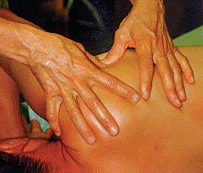Frozen Shoulder
By far, the coolest joint in the body (to me) is the shoulder. It moves in absolutely every direction. The hips are a close second, but there is limited mobility in certain planes of movement.
Mobility in the shoulder provides us all with a multitude of ways to perform very simple everyday activities. The ligaments that hold the upper arm bone, the humerus, a.k.a. the ‘funny bone’, in the socket are quite loose to allow for this wide range of motion. Because they are lax, they don’t do much to hold the shoulder together. Another fact is that the socket in which the top or the “head” of the humerus sits, is a very shallow, concave surface.
What really holds the shoulder together and stabilizes the joint are muscles that are referred to as the rotator cuff (no, it’s not your ‘rotary cup’). There are four small muscles that run from the shoulder blade to the humerus. These muscles completely surround the humerus like a sleeve or cuff. They are very dynamic, contracting to stabilize the shoulder when needed or relaxing to allow you to move the arm freely. The movement of our shoulder is so free and easy that we often take it for granted.
How does a shoulder “freeze“?
Frozen shoulder, also referred to as adhesive capsulitis, typically starts with a minor injury. For example, you may jar your shoulder by tripping and breaking your fall with an outstretched arm. It may also start after an inflammatory problem, like a little tendinitis or bursitis of the shoulder.
When we experience pain in any joint, we will instinctively limit the movements of this area in the hopes of avoiding any further discomfort. Although it is important to limit the movement in the first 24-48 hours of such an injury, further prolonged splinting of the shoulder joint can create a vicious cycle that begins to see a buildup of adhesions (scar tissue). This limited movement in conjunction with the buildup of scar tissue can began to create fibrous tissue around the ligaments, causing them to “lock down”. The greatest area of concern is the lower part of the joint where the ligamentous tissue becomes most lax when immobilized.
Once these adhesions begin to form, the shoulder starts to feel stiff and uncomfortable. You’ll limit your movement in response to the pain and the reduced movement causes more stiffness. Before you know it, you’re trapped in what seems to be a malicious cycle.
If you don’t take care of the problem immediately, it will progress from a little discomfort to severe pain that can interfere with some of the most mindless tasks such as brushing your teeth or combing your hair. After a period of prolonged disuse, your shoulder will become, in a sense, frozen. This lack of movement also begins to cause pain both down the arms and into your neck, causing a cascading impact of what started out as a minor injury.
 If you catch this problem in its early stages, some self-care exercises can assist in regaining full mobility of the joint. Massage is another means in which to tackle this issue early on, but as the adhesions become thick and the pain slowly increases, manual therapy can seem like a form of medieval torture. Personally, I have handled many advanced cases of frozen shoulder with very positive outcomes, but it was not without the great efforts of my patients to be capable of both handling this discomfort (to put it mildly) as well as significant efforts on their part when it came to self-care.
If you catch this problem in its early stages, some self-care exercises can assist in regaining full mobility of the joint. Massage is another means in which to tackle this issue early on, but as the adhesions become thick and the pain slowly increases, manual therapy can seem like a form of medieval torture. Personally, I have handled many advanced cases of frozen shoulder with very positive outcomes, but it was not without the great efforts of my patients to be capable of both handling this discomfort (to put it mildly) as well as significant efforts on their part when it came to self-care.
Conventional treatment for severe cases usually involves manipulation while under an anesthetic. A surgeon will put you under, and while you are asleep, force the joint through a complete range of motion, pulling apart any adhesions. In certain cases, surgery may be required where they need to go in and cut through the adhesions.
Typically, prior to this approach, the doctor may recommend the use of NSAID’s or a cortisone shot. Regardless, one should not expect a speedy resolution to a true condition of frozen shoulder.
There are cases however, that I have been presented with, that all signs and previous diagnosis’s pointed to the shoulder being frozen, but in actuality, there were some stubborn trigger points causing the shoulder to remain immobilized due to the amount of pain the patient was feeling when moving or even while sleeping. These trigger points can be addressed and neutralized to the point where a fully recovery is achieved without the use of any surgery, cortisone or medieval torture rituals and typically in just a few treatments.
If you feel that you may be in the early stages of what seems like frozen shoulder, please discuss your treatment options with your massage therapist before a minor injury becomes a frozen pain.
